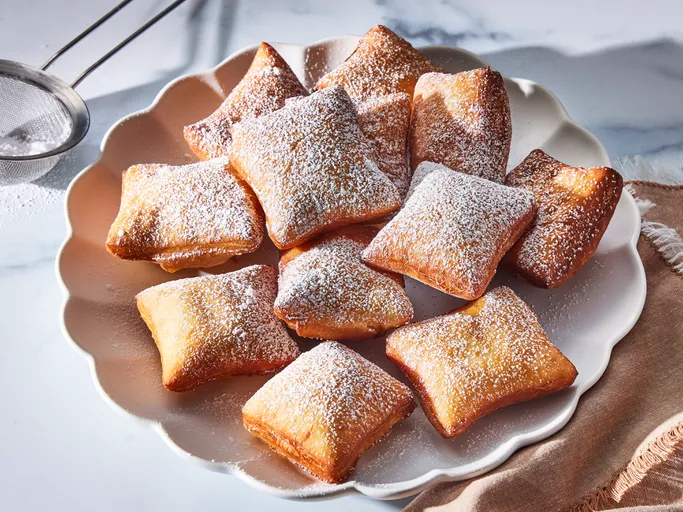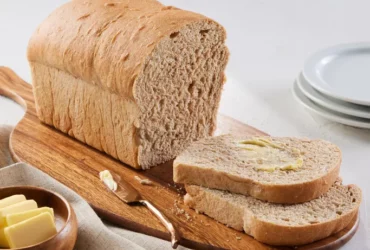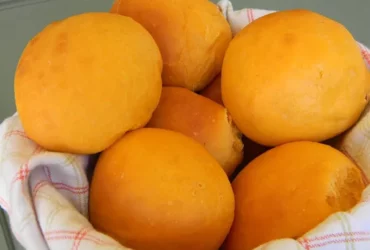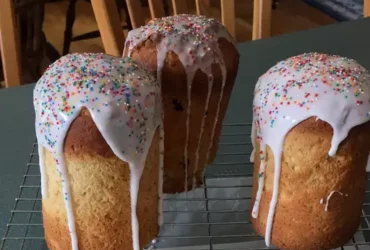Ingredients
Typical Beignet Ingredients
The traditional ingredients for beignets are quite simple yet essential to the creation of this sweet treat. At their core, beignets are essentially deep-fried doughnuts that are typically covered in powdered sugar. The most common ingredients found in a classic beignet recipe include yeast, flour, granulated sugar, salt, and warm water.
The yeast provides the necessary rise to the dough, while the flour acts as the main structural component of the beignets. Granulated sugar adds natural sweetness and helps to enhance the browning process during frying. Salt serves a dual purpose by controlling yeast growth and balancing out the flavor of the sugar.
Other ingredients that are often added to the basic dough include eggs, milk, and vegetable oil or butter for the deep-frying process. Eggs help enrich the texture of the beignets, while milk adds moisture and tenderness. The choice between vegetable oil and butter may come down to personal preference in terms of flavor and dietary considerations.
Some modern variations on traditional beignet recipes include adding spices such as nutmeg or cinnamon to create different flavor profiles. Other creative additions might include chocolate chips, fruit purees, or even nuts for added texture and interest.
When choosing ingredients for your beignets, it’s essential to select high-quality yeast that is active and suitable for baking. Using stale yeast can lead to poor rising and a less-than-desirable texture in the finished product. The type of flour used should also be considered, with all-purpose flour being a popular choice due to its versatility.
In terms of sweetener options, granulated sugar remains the most traditional choice for beignets. However, some bakers may choose to use other types of sugar or even honey to create a more unique flavor profile. Ultimately, the specific ingredients used will depend on personal preference and creative experimentation with different flavors.
The quality of the milk used can also impact the overall taste and texture of the beignets. Whole milk is often preferred for its rich, creamy flavor, but other types such as skim or 2% may also be used depending on dietary considerations and personal preference.
The key to making delicious Beignets lies in the quality and combination of ingredients used. Here’s a breakdown of what you’ll need:
- 1 package (Rapid Rise Yeast) or 2 teaspoons active dry yeast
- 3 cups all-purpose flour
- 1 teaspoon salt
- 1 cup warm water (about 105°F to 115°F)
- 1/4 cup granulated sugar
- 1/2 cup whole milk, lukewarm
- 2 large eggs
- Vegetable oil for frying
For the powdered sugar coating:
1 cup powdered sugar
Optional ingredients for added flavor and texture:
- 1 tablespoon melted unsalted butter (for brushing dough)
- 1/4 teaspoon ground nutmeg
- 1/4 teaspoon ground cardamom
- Chopped pecans or walnuts for added crunch
- Note: Traditional Beignets are made with a type of dough called ‘Pâte à Choux’ which contains butter and lard. However, this recipe uses a simpler yeast-based dough that still yields delicious results.
Ricotta cheese or a mixture of allpurpose flour, whole milk, and eggs (1 1/2 cups)
The classic beignets recipe, reminiscent of New Orleans’ famous Café du Monde, relies heavily on a few essential ingredients that work harmoniously to create the signature fried dough treats.
Ricotta cheese is often overlooked in favor of more conventional leavening agents like baking powder or yeast. However, incorporating ricotta into your beignets recipe yields an airy texture and subtle flavor.
On the other hand, some recipes opt for a mixture of all-purpose flour, whole milk, and eggs (1 1/2 cups) as their primary ingredients. This combination produces a lighter, more tender crumb that absorbs flavors well.
The type of flour used can significantly impact the final product’s texture and appearance. All-purpose flour is often preferred due to its neutral flavor and ability to produce a delicate crust.
Whole milk adds moisture, richness, and tenderness to the beignets. Using 1 1/2 cups ensures that the dough remains pliable without becoming too wet or soggy.
Eggs are an essential binding agent in this recipe. They help to hold the ingredients together while providing a subtle sheen to the finished product.
Castor sugar (2 tablespoons)
Castor sugar, also known as granulated sugar or white sugar, is a crucial ingredient in the classic beignets recipe. It serves not only as a sweetener but also plays a significant role in balancing out the flavors and textures in the dough.
The recommended amount of castor sugar in this particular recipe is 2 tablespoons. This quantity may seem minimal compared to other ingredients, but it’s essential for achieving the right level of sweetness and tenderness in the beignets.
When using castor sugar in baking, especially in sweet treats like beignets, it’s essential to note that this type of sugar is not suitable for dusting or decorating. Instead, it should be incorporated into the dough itself to distribute its sweetness evenly throughout the batter.
The properties of castor sugar make it an ideal choice for baked goods. Its fine texture and crystalline structure allow it to dissolve quickly and easily in liquid ingredients, ensuring a smooth consistency in the dough. Additionally, its neutral flavor won’t compete with other ingredients, allowing the natural sweetness of the beignets to shine through.
When measuring castor sugar, it’s crucial to use a digital or kitchen scale for accuracy. This is particularly important when working with small quantities like 2 tablespoons, as even minor variations can significantly impact the final result.
In the context of this beignets recipe, using high-quality castor sugar will not only contribute to its signature sweetness but also enhance the overall texture and aroma of the treats. Whether you’re a seasoned baker or attempting to create these iconic New Orleans-style beignets for the first time, understanding the importance of ingredients like castor sugar is vital to achieving success.
Salt (a pinch)
The ingredients used to make delicious beignets are straightforward and easily accessible, allowing anyone to attempt this classic dessert recipe.
The first key component is Salt (a pinch), a fundamental seasoning that enhances the flavor of the other ingredients without overpowering them. It’s essential to use a high-quality salt that will complement the sweetness of the sugar and the richness of the dough.
The second crucial ingredient is Granulated Sugar, which serves as the primary sweetener for these indulgent treats. The right amount of sugar is necessary to balance the savory flavors and create a delightful contrast between sweet and salty notes.
Milk or buttermilk is used in beignets recipes to add moisture and tenderness to the dough. This ingredient helps maintain a delicate balance between lightness and density, making each bite an enjoyable experience.
Eggs provide structure and richness to the dough, while also contributing to its tender crumb. Whipping eggs thoroughly with sugar will help break down their natural emulsifiers, creating a smooth batter that’s more prone to incorporating air bubbles when it comes time for frying.
Flour is an essential component of beignets, serving as both the framework and texture foundation for these fried treats. Cake flour or all-purpose flour can be used depending on preference; cake flour will yield a lighter beignet with better rise potential.
Cultural nuances abound within each beignet recipe due to regional differences in spices and other seasonings that contribute unique flavors and aromas. Feel free to experiment by incorporating vanilla extract, lemon zest, or cinnamon powder into your mixture for a distinctive twist.
It’s also worth noting the use of flavorless extracts like almond extract in some traditional recipes, which may add a hint of depth and warmth without overpowering other ingredients.
A pinch of salt helps to bring out flavors across all levels of this dessert. Don’t be afraid to experiment with the ingredient balance while learning your way around a beignets recipe.
The ingredients used in making beignets are fundamental to the recipe’s success. These sweet fried dough pastries require a specific combination of components, which include:
All-purpose flour: This is the main ingredient that provides structure and texture to the beignets. Use unbleached, all-purpose flour with a high protein content (around 12%) for the best results.
Granulated sugar: Adding granulated sugar gives the beignets their characteristic sweetness and helps balance out the bitterness of the flour. A moderate amount of sugar is sufficient, as excessive sugar can make the dough difficult to handle.
Active dry yeast: Yeast fermentation is responsible for the light and airy texture of beignets. Using active dry yeast ensures that the dough rises properly, resulting in a tender and soft interior.
Salt: A pinch of salt enhances the flavor and helps control the yeast’s growth, preventing over-proofing. Use kosher or sea salt for its distinct flavor profile.
Unsalted butter, melted: Adding melted butter to the dough contributes to the beignets’ rich flavor and tender crumb. Use high-quality, unsalted butter for the best flavor.
Egg yolks: Egg yolks add moisture, richness, and a subtle depth of flavor to the beignets. Whisk the egg yolks lightly before adding them to the dough.
Water: The amount of water needed will depend on the humidity in your environment and the type of flour used. Use lukewarm water for yeast activation and easier dough handling.
The proportions and quality of these ingredients significantly impact the final product’s taste, texture, and appearance. Be mindful of ingredient ratios and choose high-quality components to achieve authentic beignets with a delicate balance of flavors.
Instructions
Making the Dough
To make the dough for beignets, you will need to combine the following ingredients:
1 cup warm water
2 teaspoons active dry yeast
3 tablespoons granulated sugar
4 cups all-purpose flour
1 teaspoon salt
In a small bowl, combine the warm water and yeast. Let it sit for 5-10 minutes, or until the mixture becomes frothy.
Next, in a large mixing bowl, whisk together the sugar, flour, and salt.
Add the yeast mixture to the dry ingredients and mix until a shaggy dough forms.
Knead the dough on a floured surface for 5-10 minutes, or until it becomes smooth and elastic.
Place the dough in a greased bowl, cover it with plastic wrap, and let it rise in a warm place for about an hour, or until it has doubled in size.
Punch down the dough and turn it out onto a floured surface.
Roll out the dough to a thickness of about 1/4 inch (6 mm).
Use a round cookie cutter or a glass to cut out circles of dough. You should be able to get about 12-15 circles from one batch of dough.
You can also use a pastry bag and a round tip to pipe the dough into beignet shapes.
Cover the cut-out dough with plastic wrap and let it rise for another 30-45 minutes, or until it has puffed up slightly.
To make the perfect beignets recipe, it’s essential to follow a set of clear instructions that guide you through each step of the process. A good set of instructions should be precise, concise, and easy to understand.
For a beignets recipe, this might involve explaining how to activate yeast correctly, which is a critical component in making dough rise. This could include providing information on the ideal temperature for activating yeast, as well as the correct ratio of warm water to sugar needed for activation.
In addition to explaining the basic chemistry behind the recipe, instructions should also provide clear guidance on preparation and execution. For instance, they might explain how to properly mix and knead the dough, including what kind of mixing bowl and utensils to use.
The instructions could also include information about resting and proofing the dough, which is crucial for developing flavor and texture in beignets. This might involve explaining the ideal temperature and humidity levels needed for proper rising, as well as how often to punch down the dough during this process.
Furthermore, a good set of instructions should also provide guidance on frying techniques, such as maintaining the correct oil temperature and ensuring that the beignets are fried evenly. This might involve explaining how to gauge the right level of doneness and how to remove excess oil from the beignets.
The instructions could also cover tips for serving and storing beignets, including how to keep them fresh and how to package them for transport or storage. For instance, they might suggest using wax paper or airtight containers to preserve freshness and prevent moisture from accumulating.
In a large mixing bowl, combine the dry ingredients. Add ricotta cheese or the flour mixture and castor sugar.
The art of following instructions lies at the heart of any successful culinary endeavor, including the preparation of beignets. A classic New Orleans treat, beignets are a staple of the city’s rich gastronomic heritage.
In this case, we’re not just dealing with any ordinary recipe, but rather one that requires precision and attention to detail in order to achieve the perfect balance of flavors and textures.
Why Instructions Matter
The importance of instructions cannot be overstated when it comes to cooking. Without clear guidance, even the most skilled cooks can end up with a dish that’s far from what they intended.
- Following instructions ensures consistency and reliability in the kitchen.
- It helps to prevent mistakes and errors that can be costly in terms of time, ingredients, and even reputation.
- Instructions provide a framework for experimentation and innovation, allowing cooks to try new techniques and flavor combinations while maintaining control over the end result.
The Beignet Recipe: A Test Case
With this beignets recipe, we’ll demonstrate the importance of clear instructions by walking you through each step of the process. From combining dry ingredients to frying the dough, every detail matters.
Let’s take a closer look at what’s involved:
Step 1: Combine Dry Ingredients
In a large mixing bowl, combine:
- 2 cups of all-purpose flour
- 1 teaspoon of salt
- 1 teaspoon of sugar
Step 2: Add Wet Ingredients
Add to the dry ingredients:
- 1/4 cup of ricotta cheese
- 1/4 cup of melted butter
- 1 egg, beaten
Step 3: Mix and Knead the Dough
Mix the ingredients until a smooth dough forms. Knead the dough for about 5-7 minutes, until it becomes elastic and slightly sticky.
Step 4: Let the Dough Rise
Cover the dough with plastic wrap or a damp cloth and let it rise in a warm place for about an hour, or until it has doubled in size.
Step 5: Shape the Beignets
Punch down the dough and roll it out to about 1/4 inch thickness. Cut into squares or use a cookie cutter to create fun shapes.
Step 6: Fry the Beignets
Fry the beignets in hot oil until golden brown, about 2-3 minutes per side.
Step 7: Dust with Powdered Sugar
Dust the fried beignets with powdered sugar and serve immediately. Enjoy!
Mix all ingredients together using a wooden spoon until a smooth dough is formed.
To create the perfect beignets, follow these instructions carefully to achieve the desired texture and flavor.
Mixing the ingredients together is a crucial step in preparing the dough for frying.
Here are the steps to mix all the ingredients together using a wooden spoon until a smooth dough is formed:
- Add the yeast, sugar, salt, eggs, and flour to a large mixing bowl. Whisk the ingredients together to combine them.
- Using the wooden spoon, gradually add warm milk (around 105°F) while continuously whisking the mixture to prevent lumps from forming.
- Continue to mix and knead the dough for about 5-7 minutes until it becomes smooth and elastic. This can be done manually with the wooden spoon or using a stand mixer with a dough hook attachment.
- Add more flour if necessary to achieve the right consistency, which should be slightly sticky but manageable to knead.
- Turn the dough onto a lightly floured surface and knead for an additional 2-3 minutes until it becomes smooth and elastic.
Once you have achieved the desired dough consistency, cover the bowl with plastic wrap or a damp cloth and let it rise in a warm, draft-free place for about 1 hour, or until it has doubled in size.
To make a delicious batch of beignets, it’s essential to follow a series of instructions that will guide you through the process.
Step 1: Gather Ingredients and Equipment
Start by gathering all the necessary ingredients and equipment:
- Active dry yeast
- All-purpose flour
- Eggs, beaten
- Milk
- Vanilla extract
- Confectioners’ sugar
- Cooking oil or vegetable oil for frying
- A mixing bowl
- A measuring cup
- A whisk
- A rubber spatula
- A deep frying pan or a deep fryer
Make sure you have all the ingredients and equipment within arm’s reach to avoid any confusion or delays.
Step 2: Activate the Yeast
Mix the yeast with 1 cup of warm water (around 105°F to 115°F) in a small bowl. Stir gently until the yeast dissolves, then let it sit for 5-10 minutes until it becomes frothy and bubbly.
Step 3: Mix the Dough
In a large mixing bowl, combine:
- 1 cup warm milk (around 105°F to 115°F)
- 2 tablespoons granulated sugar
- 4 cups all-purpose flour
- The yeast mixture from step 2
Mix the dough using a wooden spoon or a stand mixer until it becomes smooth and elastic. You may need to add more flour or water to achieve the right consistency.
Step 4: Let the Dough Rise
Knead the dough for 5-10 minutes, then place it in a greased bowl, turning it to coat evenly.
- Cover the bowl with plastic wrap or a damp cloth
- Place it in a warm, draft-free area (around 75°F to 80°F)
- Let it rise for about 1 hour until it has doubled in size.
Step 5: Punch Down the Dough
Punch down the dough to release any air bubbles, then divide it into 12-15 equal pieces. Roll each piece into a ball and flatten it slightly into an oval shape using your hands or a rolling pin.
Step 6: Fry the Beignets
Heat about 1-2 inches (around 2-3 cm) of oil in a deep frying pan or a deep fryer to around 375°F. When the oil is hot, add the beignets to the oil and fry until they are golden brown, about 2-3 minutes per side.
Step 7: Dust with Confectioners’ Sugar
Once the beignets are fried, remove them from the oil with a slotted spoon and place them on paper towels to drain excess oil.
Dust the beignets generously with confectioners’ sugar while they are still warm.
Step 8: Serve
Serve the beignets immediately, either as a snack or dessert. You can also store them in an airtight container at room temperature for up to 24 hours.
Tips and Variations
- To make chocolate-covered beignets, drizzle melted chocolate over the confectioners’ sugar before serving.
- To add flavor to your beignets, try using different extracts (such as almond or coconut) or spices (such as cinnamon or nutmeg).
- For a more indulgent treat, top your beignets with whipped cream and fresh fruit.
Final Touches
Frying and Dusting
When it comes to making beignets, the final touches are crucial in achieving that perfect texture and presentation.
The first step in adding the finishing touches to your beignets is dusting them with powdered sugar. This is a critical component of traditional New Orleans-style beignets, and it’s essential to do it correctly.
Steps for Dusting Beignets
- Have the powdered sugar ready and easily accessible.
- Allow the beignets to cool down slightly before dusting them with powdered sugar. This will prevent the sugar from dissolving into the oil or sticking to the beignets unevenly.
- Hold a wire rack over a piece of parchment paper or a clean surface to catch any excess sugar.
- Pick up each beignet and gently tap off any excess powdered sugar by tapping it lightly on the wire rack. This will ensure that the beignets are evenly coated with powdered sugar.
Alternatively, you can use a sifter or a fine-mesh strainer to dust your beignets with powdered sugar. This method is ideal for achieving an even coating of sugar without any lumps or clumps.
Other Final Touches
- Frying the beignets until they’re golden brown and puffed up.
- Taking the beignets out of the oil with a slotted spoon and placing them on a wire rack to drain excess oil.
When it comes to frying, make sure to heat the oil to the right temperature (between 375°F to 400°F) to achieve that perfect golden brown color. It’s also essential to not overcrowd the pot with too many beignets at once, as this can cause them to stick together or become greasy.
Dusting your beignets with powdered sugar and frying them until they’re golden brown are just a couple of the final touches that will make your beignets truly special. With these steps, you’ll be able to create delicious, authentic New Orleans-style beignets that are sure to impress your family and friends.
The final touches are what make all the difference between a good beignet and a great one. Here are some key considerations to ensure your beignets turn out perfectly.
Quality Ingredients: The quality of your ingredients can greatly affect the taste and texture of your beignets. Be sure to use high-quality milk, eggs, and flour to get the best results.
Temperature Control: The temperature of your oil is crucial when making beignets. If it’s too hot, your beignets will burn on the outside before they’re fully cooked inside. If it’s too cold, they’ll absorb too much oil and be greasy.
Frying Time: Be sure to fry your beignets for just the right amount of time. This can vary depending on the size of your beignets and the temperature of your oil.
Sugar Coating : While not essential, a light dusting of powdered sugar can add a nice touch to your finished beignets.
Frying Techniques: There are several techniques you can use when frying beignets.
Here are some tips:
- Tongs: Use tongs or a slotted spoon to carefully place the beignets in the hot oil.
- Drain Excess Oil: Once you remove your beignets from the oil, use paper towels or a clean cloth to drain excess oil.
Finishing Touches: After frying and draining your beignets, it’s time for the final touches. Here are some ideas:
Sugar Dusting : Lightly dust the beignets with powdered sugar.
- Pastry Box: Place the cooled beignets in a pastry box or container to keep them fresh and add a decorative touch.
The final touches are what set your beignets apart from store-bought ones. By paying attention to details such as temperature control, frying time, sugar coating, and finishing touches, you can create truly delicious beignets that will impress anyone.
Dust the beignets with powdered sugar after frying for 12 minutes on each side, or until golden brown.
To add the final touches to your crispy and sweet beignets, it’s essential to dust them with powdered sugar immediately after frying. This will ensure that the sugar adheres evenly to the warm beignets and creates a beautiful presentation.
Begin by preheating your oil in a deep fryer or a large pot to around 375°F (190°C). Once the oil is hot, carefully place the beignet dough balls into the oil, making sure not to overcrowd it. Fry the beignets for 12 minutes on each side, or until they are golden brown and puffed up.
While the beignets are still warm, use a fine-mesh sieve or a piece of cheesecloth to dust them with powdered sugar. You can also use a sifter or a small strainer for this purpose. Make sure to cover the entire surface of each beignet with an even layer of powdered sugar.
To achieve the perfect amount of powdered sugar, start by sprinkling a small amount over the beignets and then gently shake them back and forth to allow the excess sugar to fall off. Repeat this process until you reach the desired level of sweetness and texture.
Once your beignets are fully dusted with powdered sugar, place them on a wire rack or a paper towel-lined plate to cool slightly. This will help prevent the sugar from melting and creating a sticky mess. Serve your freshly made beignets warm and enjoy!
Remember that the key to achieving the perfect beignet is in the details, including the amount of powdered sugar used. Start with a small amount and gradually add more as needed to avoid overpowering the delicate flavor of the beignets.
By following these steps and adding the final touches of powdered sugar, you’ll be able to create delicious and visually appealing beignets that are sure to impress your family and friends.
Serve warm.
The final touches on your beignets recipe are just as important as the initial preparation to ensure that they turn out perfectly fluffy and delicious.
Once you have finished frying your dough, it’s time to add the finishing touches. This includes sprinkling powdered sugar over the top of each beignet while still warm, which will help the sugar stick to the fried dough.
Be sure to use a high-quality powdered sugar that is fresh and has not been exposed to air for too long, as this can cause it to become clumpy or develop an unpleasant flavor. You can also add a pinch of salt to balance out the sweetness of the powdered sugar if desired.
To serve your beignets, place them on a wire rack or tray lined with paper towels to drain any excess oil. This will help prevent the beignets from becoming greasy and soggy.
While still warm, use a spatula to transfer the beignets to a serving dish or individual plates. You can also serve them in a basket or on a platter for a more rustic presentation.
Be sure to serve your beignets immediately after frying, while they are still warm and fresh. This will ensure that they retain their texture and flavor. If you must wait before serving, make sure to store them in an airtight container to prevent them from becoming soggy or developing off-flavors.
It’s also worth noting that the ideal temperature for serving beignets is between 160°F and 180°F (71°C to 82°C). This will help to bring out the flavors and textures of the fried dough, making it even more delicious and enjoyable to eat.
Finally, consider offering a variety of toppings or fillings to complement your beignets. Some popular options include chocolate dipping sauce, caramel sauce, whipped cream, fresh fruit, or sprinkles. This will allow your customers or guests to customize their beignet experience and make it even more enjoyable.
- Best Lusha Alternatives for 2025 - April 22, 2025
- Best Overloop Alternatives for 2025 - April 22, 2025
- Best 6sense Alternatives for 2025 - April 22, 2025















